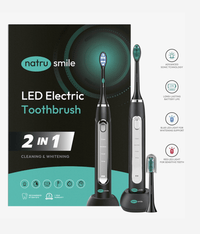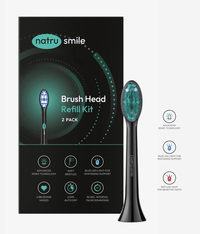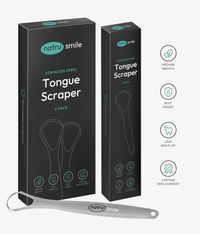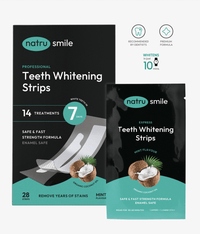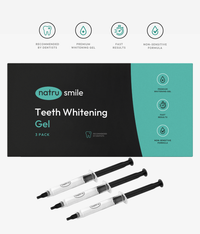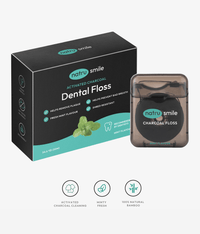
All products are certified by dental expert Dr. Greg Grillo
Even if you're new to teeth whitening, you've probably seen the light-activated treatments that dentists offer.
The procedure involves shining a special light onto your teeth, typically after applying a bleaching material.
Many companies offer a similar process at home—smaller, light-powered teeth whitening kits are commonplace at supermarkets and drug stores nationwide.
But do these treatments actually help? Or are they purely a marketing ploy? It depends.
In a study published in the Journal of Conservative Dentistry, researchers discovered that teeth whitening procedures that utilize laser, halogen, or LED light-activation led to greater lightening of tooth shade and maintained the lighter shade for a longer period compared to non-light-activated methods. The most effective methods were found to be laser and halogen lights.
This article shows you how different whitening lights work, what they can do, and what they can't.
What Are Teeth Whitening Lights, And How Do They Work?
Teeth whitening describes the processes used to lighten the color of teeth, which involve either a physical removal of stains on teeth or a chemical reaction that whitens teeth from the inside.
Teeth whitening lights are specially designed devices used in conjunction with chemical whitening agents to speed up and enhance the teeth whitening process. They have gained popularity due to their efficiency, long life, and immediate high-intensity output, making them an attractive option for both in-office and at-home teeth whitening treatments.
Patients have three options when choosing a treatment using whitening lights:
- UV (ultraviolet) whitening uses a laser to administer magnetic radiation that heats up the tooth during the whitening process. This process must be performed in-office because of the risk of burining the surrounding tissue.
- Halogen whitening also involves heating the tooth to catalyze the whitening process (halogen light also lets off some UV radiation). It is best performed in-office as well.
- LED whitening is the most common (and safest) form of whitening lights. The blue LED light speeds up the whitening process by activating the hydrogen peroxide rather than radiating heat. At-home kits use LED technology, making them less risky and more convenient than other options.
During light-activated whitening treatments, users first apply the chemical agent (i.e., hydrogen or carbamide peroxide gel). Then, the light activates the gel and helps it penetrate deep into the enamel, breaking up stains and discolorations that are much harder to remove.
It's important to note that the whitening light itself does not directly whiten the teeth—it merely acts as a catalyst, speeding up the chemical reaction between the teeth and the whitening agent. Without the chemical whitening gel present, the LED light would have no effect on the color of your teeth.
Is It Safe To Use Teeth Whitening Lights?
Whether or not teeth whitening lights are safe depends on how well they are applied and where you receive treatment.
UV light treatments are considered risky if they are used improperly. They can burn the soft tissue in your mouth, irritate your gums, increase your level of tooth sensitivity after whitening, and even cause damage to your teeth and dental restorations.
LED light treatments are generally safer. But users still run the risks of misapplication, gum irritation, and increased sensitivity.
When using LED whitening at home, make sure to carefully follow the manufacturer's instructions—especially recommended duration for using the whitening agent and LED light.
Blue Light Teeth Whitening Side Effects
Most of the side effects of teeth whitening are still risks for LED whitening. Since whitening treatments involve chemically altering your teeth (which aren't naturally white) beneath the surface, the treatment will affect the nerves and soft tissues in your mouth.
Common side effects of light-activated teeth whitening include:
Tooth Sensitivity And Irritation (During And After Treatment)
Tooth sensitivity is the most common side effect associated with teeth whitening treatments, including those that use LED teeth whitening lights. It can occur during and after the treatment, with some clinical trials reporting more than half of participants experiencing sensitivity during or following the procedure.
Some patients experience tooth sensitivity even when using products with formulations that are meant to be less sensitive. But it is most common in high-concentration treatments (i.e., those with over 10% hydrogen peroxide).
During UV and halogen treatments, patients often feel a tingling or burning sensation in their teeth. In LED treatments like Zoom whitening, heat isn't used, so the patient doesn't typically feel the same level of sensitivity during treatment.
After treatment, teeth are dehydrated and more sensitive to hot, cold, sweet, and acidic foods. This sensitivity should subside within a few days of the treatment, but rehydrating your teeth after whitening plays a big role in minimizing it.
Gum Inflammation
When you apply whitening gel to your teeth, some of it will come into contact with your surrounding gum area.
Especially if you don't use the right concentration and duration of whitening gel, your gums will become irritated (and potentially inflamed) during the treatment.
Before an in-office whitening treatment, your dentist will typically apply a film or desensitizing agent to your gums for protection. With at-home whitening treatments, you won't likely have the same level of protection.
Uncomfortable Feeling In The Mouth
The result of the two above side effects is an overall feeling of discomfort in the mouth, which patients usually felt during and after treatment.
Some patients describe the feeling as a mild tingling or burning sensation, as well as general soreness throughout the entire area.
Others feel more pronounced discomfort, including pain and throbbing in the affected areas.
The severity of the sensation is determined mostly by a patient's oral health and the concentration of whitening gel used.
Damage To Dental Restorations (If Applied Too Often Or For Too Long)
Dental restorations can be impacted by whitening treatments, especially heat treatment from UV and halogen lights.
Composite bonding, veneers, and crowns bond to your teeth with a chemical adhesive. Excessive heat can cause the bond between the adhesive and your real tooth to weaken, resulting in the restoration loosening or falling off.
LED lights don't typically cause this problem because they do not generate enough heat to damage dental restorations.
Dental restorations also do not respond to the color-changing effects of whitening, so patients also need to consider the potential of an uneven whitening effect.
Unsatisfactory Results
Teeth whitening is meant to improve your smile, but it doesn't guarantee satisfaction.
Whether you use an in-office or at-home whitening treatment, the results are not always perfect. Most patients who aren't happy with their treatment have one of the following problems:
- Uneven whitening shades. If some of your teeth are whiter than others or the shade of white isn't what you expected, it can be disappointing.
- Stains that don't respond to whitening products. Teeth are naturally porous and can absorb staining agents from things like coffee, tea, red wine, and tobacco. If your teeth have deep-set stains in them (e.g., from aging, decay, or dead teeth), they may not be removable with a whitening product.
- Not achieving a whiteness level that you are happy with. Depending on your teeth's natural shade and their condition, it may take multiple treatments before you achieve the desired results.
Using the proper teeth whitening treatment for your needs (and using it for the correct amount of time) can help you minimize your risk of unsatisfactory results.
Long-Term Damage
You might think you need to use multiple whitening products throughout the year to keep your teeth white.
In reality, whitening results can last for years. And overuse of whiteners can cause significant damage to your teeth if you aren't careful.
Whitening products contain peroxide, which can erode away the protective enamel on your teeth and make them more susceptible to decay and discoloration in the long-term.
If you want to maintain your shade of white, you can try natural teeth whitening methods like oil pulling or homemade baking soda paste.
In-Office Blue Light Teeth Whitening Procedure
For best results, patients usually choose an in-office whitening procedure in which a dentist applies a blue light to their teeth.
To better understand how teeth whitening lights work, let's delve into the process step by step
1. Application Of The Whitening Agent
Before exposing the teeth to the LED light, a whitening gel containing an active ingredient like hydrogen or carbamide peroxide is applied to the teeth. This gel is responsible for breaking down the stains on the tooth enamel.
2. Activation Of The Whitening Agent
Once the gel is in place, the LED teeth whitening light is positioned in front of the teeth. The blue light the LED light emits interacts with the peroxide in the gel, activating it and accelerating the chemical reaction.
3. Penetration And Stain Removal
As the chemical reaction takes place, the activated whitening agent breaks down the stains within the tooth enamel, effectively lifting and lightening them. The LED light helps the whitening agent to penetrate deeper into the enamel, targeting stubborn stains that might not be removed with traditional whitening methods.
4. Completion Of The Process
The LED light is typically used for a predetermined amount of time, usually between 20-45 minutes, depending on the concentration of the whitening gel and the desired level of whitening. After the treatment, the gel is removed, and the teeth are rinsed thoroughly.
Using Blue Light Teeth Whitening Products At Home
If the cost of whitening your teeth in-office is too high for you, there are plenty of products you can use at home.
At-home whitening kits require additional care, as they are not administered under professional guidance.
Here is a step-by-step guide to whitening your teeth at home with LED light:
1. Choosing The Right Whitening Product
Select an at-home teeth whitening kit that includes a blue LED light device and a whitening gel, preferably from a reputable brand with positive reviews.
Zoom is the most well-known brand, but you may want to choose one specially formulated for sensitive teeth.
2. Preparing Your Teeth
Before beginning the treatment, brush and floss your teeth to remove any food debris and plaque, ensuring a clean surface for the whitening gel to work effectively.
If you are incorporating your whitening procedure into your daily oral care routine, remember to brush your teeth beforehand.
3. Applying The Whitening Gel And Activating The Light
Carefully apply the whitening gel to the provided tray or directly onto your teeth, taking care to avoid contact with your gums. Be mindful of the manufacturer's recommended amount of gel to minimize gum irritation.
Turning the light on is straightforward—all you have to do is insert the LED light into the tray and press the button. Depending on your product, you may be required to turn it off manually once the treatment is complete.
4. Completion Of The Procedure
Most products require between 15-20 minutes for a single session.
After waiting for the allotted time, remove the LED light and rinse your mouth with water.
Check the manufacturer's instructions to see if they recommend repeating the procedure for a few days or weeks, depending on the level of discoloration in your teeth.
Other Types Of Light Teeth Whitening Treatments
Although blue LED whitening lights are the safest, you have two other teeth whitening options: UV and halogen light.
Ultraviolet Light
Ultraviolet light has been used for teeth whitening in the past, but it is less common today due to safety concerns. UV light can be effective at activating the whitening agent in the gel, but it also poses risks. Exposure to UV light can cause damage to the skin, eyes, and oral tissues, leading to potential cell mutations and an increased risk of cancer.
While some dental professionals may still offer UV light treatments, the American Dental Association (ADA) does not endorse their use due to the potential health risks.
If you're considering a UV teeth whitening treatment, the level of exposure won't be enough to cause long-term harm. But if you plan to use UV light regularly, it's safer to opt for an LED whitening treatment instead.
Halogen Light
Halogen teeth whitening is another option that was more commonly used before the advent of LED technology. Halogen whitening emits a broad spectrum of light, activating the gel's whitening agent. But this type of light also generates heat, which can cause discomfort or sensitivity during the treatment.
While halogen light may provide effective teeth whitening results, heat can pose risks, such as gum irritation and tooth sensitivity.
Want to learn more? These are the questions our customers ask us the most.
Does LED Teeth Whitening Damage Enamel?
Blue LED light does not have any impact on the teeth themselves, only the reaction between the teeth and the whitening gel. The whitening process can damage your enamel if done incorrectly or if the whitening product is overused. Long-term damage is also a more serious risk when patients have preexisting or undiagnosed dental health problems.
Does LED Light Whiten Without Gel?
LED light does not do anything for teeth. It only catalyzes the whitening process by activating the whitening gel that removes surface stains. The light does not penetrate deep enough to affect the underlying teeth pigment, so it would be impossible to whiten a tooth without the use of a whitening gel.
How Long Will LED Light Teeth Whitening Take?
The duration of your whitening treatment depends on several factors. Most patients take between 30 minutes and one hour per session and see results after the first few days of treatment. Your dentist or whitening technician will advise you on the best course of action for your individual situation.
Can I Use LED Light With Teeth Whitening Strips?
Due to the high concentrations of peroxide compounds in whitening gels, it is best to use them on their own. Teeth whitening strips are also high-intensity treatments (that should only be used once every six months), and using both at the same time can worsen your side effects and damage your enamel.
Is LED Light Good For Whitening Teeth?
LED light is excellent for speeding up the whitening process and making it more effective. Those who want long-lasting whitening results from in-office or at-home treatments often turn to LED whitening because of its fast-acting properties. LED light is also good for reducing sensitivity and discomfort during whitening, making it a safe and beneficial option for people with sensitive teeth.
Can You Use Blue Light Teeth Whitening In-Office?
Most people opt for in-office whitening despite its higher price tag because of its safety and effectiveness in achieving results quickly. Blue light teeth whitening is commonly used in-office, taking one hour or less per session to complete. During this time, the dental professional will use a small wand or crane that shines a blue light on your teeth to enhance the whitening effect of the gel.
Are All LED Teeth Whitening Lights The Same?
Functionally speaking, all LED lights are about the same. The frequency of blue light they use is similar, as is the power output.
Some lights may be more powerful than others, but this won't necessarily produce better results. The main difference between LED whitening lights will be their shape and size, which may affect how comfortable they are for the patient to use during treatment.
Some patients also achieve better or worse results depending on the brand they use and its accompanying gel.
What Is The Purpose Of LED Light For Teeth Whitening?
LED light for teeth whitening is used to accelerate the whitening process. The light activates the whitening gel and helps to break down stains more quickly, resulting in whiter teeth in a shorter amount of time. LED lights also help reduce discomfort during treatment, making it easier for patients with sensitive teeth to enjoy professional-grade results without experiencing sensitivity or pain.
Is Blue Light Teeth Whitening Healthy?
Research has shown blue light teeth whitening to be safe for teeth. Whether or not teeth whitening is actually healthy for teeth is debatable—teeth are not naturally white and the long-term effects of whitening treatments can't be guaranteed.
That said, blue light teeth whitening does not add additional harsh chemicals or bleaches to the process, so it is relatively safe for most people to use. As with any medical procedure, you should always consider the potential long-term effects beforehand.
How Often Should You Whiten Your Teeth With Blue Light?
You should use LED teeth whitening no more than twice per year (every six months). Many patients achieve results for up to two to three years, so this might not be a major concern. The implications of over-whitening your teeth include weakened enamel, increased sensitivity, and even discoloration.
Do Dentists Recommend LED Teeth Whitening?
Using LED light to accelerate the whitening process is common practice in the dental field. Dentists often recommend LED teeth whitening to those who want faster results, less discomfort during treatment, and long-lasting results.
How Long Does LED Teeth Whitening Last?
For those with healthy habits, LED teeth whitening can last for up to two to three years before needing to be refreshed. That said, how long the results from an LED teeth whitening procedure last depends largely depends on a patient's oral health and lifestyle habits. A poor brushing routine, tobacco use, and an unhealthy diet can adversely affect the longevity of whitening results.
The Bottom Line
Teeth whitening lights work for their intended purpose—that is, to accelerate the whitening process by catalyzing the reaction of the gel with the teeth.
Although LED whitening is safe, it is best to limit professional-grade whitening treatments to twice a year or less and to take all necessary precautions in order to ensure long-lasting results.
Most importantly, always consult with your dentist before beginning any whitening treatment, as they can suggest the best approach for you based on your personal needs.


